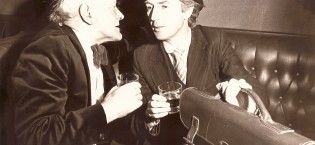Passion Play Opens in Sligo’s Dominican Church
 “The Man born to be King” received a tremendous first night reception from a capacity audience at Sligo’s Holy Cross Priory last night when the play depicting the Passion, Death and Resurrection of Jesus Christ began a week-long run. The production not alone marks the end of an era so far as the Dominican Order in Sligo is concerned, but it is the first time a play of its kind was staged in the town and it is a remarkable indication of the affection and esteem with which the Dominican Fathers are regarded by the people of Sligo.
“The Man born to be King” received a tremendous first night reception from a capacity audience at Sligo’s Holy Cross Priory last night when the play depicting the Passion, Death and Resurrection of Jesus Christ began a week-long run. The production not alone marks the end of an era so far as the Dominican Order in Sligo is concerned, but it is the first time a play of its kind was staged in the town and it is a remarkable indication of the affection and esteem with which the Dominican Fathers are regarded by the people of Sligo.
It is a production of historical significance, mainly because when the play ends its run, the 126-years old church in which it is being presented will be demolished to make way for an ultra-modern building. The Friary, as it is known to all, will no longer be a feature of the Sligo skyline and it is entirely appropriate that the play, in all its splendour and impact, should serve to express Sligo’s deep and abiding gratitude to the Dominicans who have an unbroken association with the town going back to 1252.
“The Man Born to be King” was written by Dorothy L. Sayers and was originally presented by the BBC thirty years ago in a cycle of twelve playlets. Three of these are incorporated in the Sligo production which re-enacts “Royal Progress” – from Gallilee to Bethany and on to Jerusalem; “King of Sorrows” – the road to Calvary and the Way of the Cross; and “The King Comes to his Own” – the resurrection of Our Lord.
It is a tremendously realistic and emotional experience for the audience, captivated as they are by the awe-inspiring and magnificent visual effect. Technically superb, it is a masterpiece of re-creating, capturing the intense human drama of the epoch it so brilliantly portrays. One of the most striking features of the presentation is the intimacy struck between the audience and the players. This is achieved by the use of a specially constructed Split-level open stage which, by its very simplicity, brings a new dimension to audience participation.
The absence of scenery might have caused some apprehension – the sheer magnitude of stage setting can be readily appreciated, but the splendour and the authenticity of the costumery create sufficient Biblical atmosphere to make the overall spectacle a remarkable and technical achievement. Another reason why this splendid production will be remembered in the history of Sligo theatre is the moving and majestic contribution of the specially augmented choir creating a spiritual presence and giving an ethereal quality to the events being presented on stage.
One of the major successes of the production is the strikingly effective lighting. Here again, the producers were faced with problems of a most difficult technical nature but they were surmounted with efficiency and dexterity. All through, the lighting blends with the mood of the play and its subtle use gives a sense of time and place far more effectively than stage setting.
“The Man Born to be King” is a personal triumph for both Walter Mc Donagh, the producer and Liam Canning, his right hand man and lighting supervisor. They were more than equal to the magnitude of their task and while many others in the production team provided expert assistance in various ways, the overall credit must go where it is due and where it is thoroughly deserved. Their achievement will be long remembered and talked about in drama circles not alone in Sligo but throughout the North-West. It is fitting that the immense amount of hard work they put into the project should be rewarded by a highly successful opening night and exceptionally heavy bookings for the rest of the week.
Incidentally, all those who intend to see the play would be well advised to book their seats immediately because it is expected that tickets will be at a premium for next week’s performances. Bringing together as it does, a cast of over one hundred people, “The Man Born to be King” is the most ambitious dramatic presentation ever undertaken locally. The tremendous enthusiasm which the play has generated in the area is reflected in the fact that many people with no previous stage experience were among the first to volunteer for parts. Major roles are filled mainly by actors of wide and proven experience, but several newcomers to the drama world give sparkling performances. Special mention must be made of leading artistes such as Tom Mullaney (Jesus Christ), Mary Watson (Virgin Mary), Joan Fitzpatrick (Mary Magdalene), Geoffrey Rose (John), Eddie Fitzpatrick (Judas), Eddie Watson (Caiphas) and John Mullaney (Pilate). Naturally, it would not be possible to mention individual performances and contributions – suffice to say that each and every member of the entire production, sound, wardrobe, make-up, backstage etc. played a vital part in this success. “The Man Born to be King” is a profoundly emotional experience: it must not be missed.
The Holy Cross Newsletter in an article entitled “The Church and Drama” last Sunday stated: “At first sight there might appear to be an uneasy partnership between the Church and drama. Some people find it strange that a Church building should be chosen for the staging of a dramatic work. Even leaving aside the fact that the Friary Church is going to be demolished soon, it is not as unseemly as people may imagine. The European theatre as we know it goes back in its origin to a liturgical beginning. In the tenth century the practice developed in France and later in England of re-enacting a scene from the Gospels on Easter morning. Three people, representing the three Marys, would come to the altar of the church and ask a fourth, an angel dressed in white, where Our Lord’s body was. They would be told ‘He is not here, He is risen as He said’.
This practice later developed into the mystery plays which were such a feature of Medieval life in France, Holland and England. They were known in Ireland too, in Dublina and Kilkenny. Various scenes were chosen from Scripture by the local guilds (carpenters, dyers, weavers etc.) and each group presented its own play in the open air at street corners on a moveable stage. Thus on feast days like Corpus Christi, the whole story of Redemption would be played out before the townspeople. It must have been a very effective means of teaching Christian doctrine. Shakespeare was influenced by this folk drama movement. To put on a play in Church, therefore, as we are doing from next Wednesday in Holy Cross, is not such a novel idea after all. It may help us to see that there is a very close relationship between liturgy and drama, and when we read the teaching of the Vatican Council we cannot escape the dramatic possibilities of the Christian liturgies. Already, since we moved the temporary altar onto the stage, there has been a heightened awareness among the people at mass. Surely there is room here for experimentation!
from The Sligo Champion, by A Special Representative, April 2nd, 1971
Tags: Dorothy L. Sayers, History, Passion Play, Press Reports, Reviews








